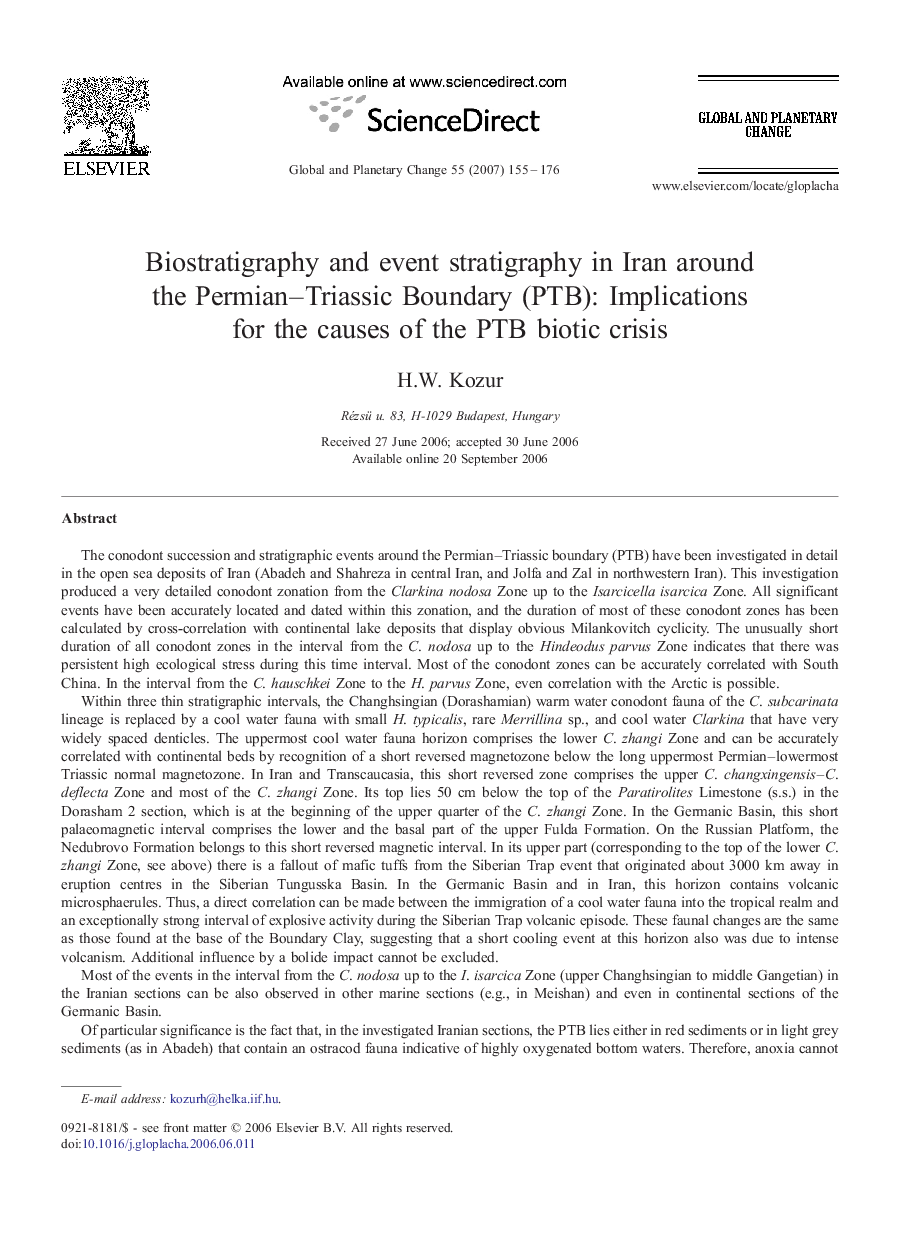| کد مقاله | کد نشریه | سال انتشار | مقاله انگلیسی | نسخه تمام متن |
|---|---|---|---|---|
| 4464421 | 1621732 | 2007 | 22 صفحه PDF | دانلود رایگان |

The conodont succession and stratigraphic events around the Permian–Triassic boundary (PTB) have been investigated in detail in the open sea deposits of Iran (Abadeh and Shahreza in central Iran, and Jolfa and Zal in northwestern Iran). This investigation produced a very detailed conodont zonation from the Clarkina nodosa Zone up to the Isarcicella isarcica Zone. All significant events have been accurately located and dated within this zonation, and the duration of most of these conodont zones has been calculated by cross-correlation with continental lake deposits that display obvious Milankovitch cyclicity. The unusually short duration of all conodont zones in the interval from the C. nodosa up to the Hindeodus parvus Zone indicates that there was persistent high ecological stress during this time interval. Most of the conodont zones can be accurately correlated with South China. In the interval from the C. hauschkei Zone to the H. parvus Zone, even correlation with the Arctic is possible.Within three thin stratigraphic intervals, the Changhsingian (Dorashamian) warm water conodont fauna of the C. subcarinata lineage is replaced by a cool water fauna with small H. typicalis, rare Merrillina sp., and cool water Clarkina that have very widely spaced denticles. The uppermost cool water fauna horizon comprises the lower C. zhangi Zone and can be accurately correlated with continental beds by recognition of a short reversed magnetozone below the long uppermost Permian–lowermost Triassic normal magnetozone. In Iran and Transcaucasia, this short reversed zone comprises the upper C. changxingensis–C. deflecta Zone and most of the C. zhangi Zone. Its top lies 50 cm below the top of the Paratirolites Limestone (s.s.) in the Dorasham 2 section, which is at the beginning of the upper quarter of the C. zhangi Zone. In the Germanic Basin, this short palaeomagnetic interval comprises the lower and the basal part of the upper Fulda Formation. On the Russian Platform, the Nedubrovo Formation belongs to this short reversed magnetic interval. In its upper part (corresponding to the top of the lower C. zhangi Zone, see above) there is a fallout of mafic tuffs from the Siberian Trap event that originated about 3000 km away in eruption centres in the Siberian Tungusska Basin. In the Germanic Basin and in Iran, this horizon contains volcanic microsphaerules. Thus, a direct correlation can be made between the immigration of a cool water fauna into the tropical realm and an exceptionally strong interval of explosive activity during the Siberian Trap volcanic episode. These faunal changes are the same as those found at the base of the Boundary Clay, suggesting that a short cooling event at this horizon also was due to intense volcanism. Additional influence by a bolide impact cannot be excluded.Most of the events in the interval from the C. nodosa up to the I. isarcica Zone (upper Changhsingian to middle Gangetian) in the Iranian sections can be also observed in other marine sections (e.g., in Meishan) and even in continental sections of the Germanic Basin.Of particular significance is the fact that, in the investigated Iranian sections, the PTB lies either in red sediments or in light grey sediments (as in Abadeh) that contain an ostracod fauna indicative of highly oxygenated bottom waters. Therefore, anoxia cannot be the reason for the PTB extinction event in this region, even though anoxia does cause locally or regionally elsewhere an overprint on the extinction event.
Journal: Global and Planetary Change - Volume 55, Issues 1–3, January 2007, Pages 155–176